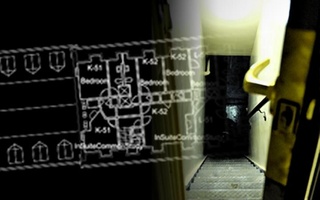Two characters are rehearsing a scene on stage. To the audience, as well as the show’s staff, their conversation is inaudible. After a few moments of apparent silence, an actor interrupts, urging the pair to “project!” To this, one objects: “I can’t. These are the kinds of things you can’t say out loud.”
The director of the show then steps in. “Well that’s very poetic and all, but you’re going to have to project anyway. We can’t hear you at all and we’re up here onstage. How is an audience out in the house going to know what’s going on?”
The tradeoff between realism and the requirements of performance, explored here in a play within a play, is a major theme in nineteenth-century playwright Luigi Pirandello’s meta-theatrical “Six Characters in Search of an Author.” Theater, like all other art, relies on illusion—the credibility of clearly fictional scenes. It is unadulterated praise for theater to be labeled ‘realistic’ or ‘honest.’ Yet theater is also deeply conventional, relying on methods that are consummately unrealistic in order to simulate reality.
“You can’t just whisper on stage,” says English Professor Martin Puchner. In April he released a book entitled “The Drama of Ideas: Platonic Provocations in Theater and Philosophy,” a discussion of philosophical playwrights like Pirandello. To the audience, he says, a whisper would be inaudible: “You have to use a stage whisper.”
Such conventions, which work artificially to make theatrical action immediate and comprehensible to the typical audience, are firmly entrenched in the customs of theatrical production. But two productions happening in Cambridge in the next few weeks directly challenge these conventions through the theatrical medium itself. A Harvard-Radcliffe Dramatic Club (HRDC) production of “6 Characters”—billed as “6” instead of “Six,” and incorporating a Harvard College setting—will run in the Loeb Drama Center Experimental Theater from October 21 to 23. In November, the Massachusetts Institute of Technology (MIT) will host a production of 30 plays from “Too Much Light Makes the Baby Go Blind,” a show created by a group of Chicago dramatists known as the Neo-Futurists to bring more direct reality to the stage.
According to Puchner, philosophical concepts have historically been viewed as antithetical to the action of dramatic art—but both of these productions manage to address the issues surrounding artistic representation while avoiding tedious pedagogy. By adding layers of illusion into its plot, “Six Characters” uses meta-theater to explore the philosophical dialectic between performance and reality. The Neo-Futurists take a drastically different approach, destructing the proverbial fourth wall between actor and audience in order to create what they believe is a more honest form of theater. Through unconventional yet different understandings of the balance between illusion and authenticity, Pirandello and the Neo-Futurists seek to test the limits of drama’s capabilities and redefine theater’s relationship with reality.
MOMENTS OF CROSSING
In “The Drama of Ideas,” Puchner argues that philosophy and theater have a conflicted history of mutual attraction and repulsion. Their first intersections occurred in Plato’s dialogues, with fictional discussions of philosophical matters. “He invented characters and placed them in settings and scenes,” Puchner says. “They exchange dialogue but its not just dry abstract philosophy. There’s a lot of human interaction in the course of these dialogues: characters get embarrassed, they tease each other.”
After a period of independence, the two forms merged again around 1900 in the dramas of George Bernard Shaw, and the works of existentialist playwrights like Samuel Beckett and Jean-Paul Sartre, and Pirandello himself. The resurgence has continued unabated, and even, in the case of Tom Stoppard, developed a major following. Still, Puchner adds, “I don’t think that all of a sudden there will be tons of Broadway shows that are philosophical dramas.” The HRDC, itself has produced numerous productions of plays by August Strindberg, Bertolt Brecht, and Sartre in recent years.
Despite this renaissance, Puchner identifies a conflicted relationship between philosophy and theater. “Both have often dissociated themselves, but then again and again there are moments of crossing,” he says.
Their frequent divergence demonstrates some mutual distrust. This tension stems in part from the apparent incompatibility of theatrical action and philosophical cogitation According to Puchner, “when you start to study theater, often the first thing you’re told is that ‘drama’ in Greek means ‘action.’ So drama should be based on action, not ideas, and if you introduce too many ideas you ruin it.” Jesse T. Nee-Vogelman, Director of the HRDC’s “6 Characters,” appears to agree. “A lot of people don’t have tolerance for that kind of thing... they want something that’s very straightforward and relaxing to watch. You want to stay away from being preachy,” he says.
Historically, philosophers have also criticized theater. “Philosophers often considered the theater a place of mere appearance, not essence, deceit rather than truth, and so felt that philosophy should actively steer away from it,” Puchner says.
On the other hand, dramatic expression can keep abstract ideas grounded. “Suddenly, philosophy is not only a question of abstract deduction and arguments, but anchors those arguments in some kind of character, in a particular situation, and therefore makes it more concrete,” says Puchner.
The collision of the two disciplines can also inspire light comedy. “One of the earliest anecdotes in the philosophical tradition, attributed to Thales, is that he was walking along, looking at the sky, and he fell into a ditch. This is the origin of the absent-minded philosopher, who has his mind in the clouds,” Puchner says. The Father in “Six Characters,” the philosophical center of the play, also plays into this comic tradition. This does not mean Pirandello thinks these ideas are ludicrous—rather, Puchner says, “both Shaw and Pirandello were masters of the comedy of ideas.”
“THE TRUTH IS WHAT WE SAY IT IS”
Part of the success of “Six Characters” is derived from its comically self-conscious treatment of these esoteric concepts. As the audience takes their seats at a performance of “6 Characters,” a cast is on stage rehearsing another play: “Rules of the Game,” also by Pirandello. “They’re talking about what a terrible play it is and how Pirandello writes this stuff that’s over the audience’s head,” says Jesse T. Nee-Vogelman ’13, Director of the HRDC production. In the midst of the rehearsal, the titular characters enter. Abandoned by their playwright and creator, they demand that their life story be finished and staged. “These characters have a story within them, they’re defined by a story, but they exist in a suspended state until they can perform their story in the theater,” Puchner says. Their interactions with the actors whoplay them are the platform for Pirandello’s meditations on theater itself. His meditations are marked by comical exaggeration of the illusions that complicate that relationship.
“The six characters inhabit several planes of existence,” writes Brandon J. Ortiz ’12, the dramaturge and translator for the production, in an email. “At their lowest level of consciousness, they are the fictional family of their potential play that was never completed by the author. They are also characters that would have been billed in that would-be drama, had it made it to the stage—characters who are now appearing in ‘real life’ during a company’s rehearsal.” And these are just the layers of which the characters are aware.
The great tragedy of the characters, according to Pirandello, is that they cannot break through the final layer of illusion to realize that they serve as amusement for another real audience. At one point, the Lead Actress uses the word ‘illusion’ in passing and elicits signs of discomfort from the six characters. The Father clutches his chest and groans with pain. “It’s just cruel, really cruel to say that word to us,” he says. “Your illusion is the only reality we have.” “They’re not so much acting out the scenes happening to them as living them,” Nee-Vogelman says.
In another seminal moment, the ‘Director’ stops the characters partway through performing a scene and has the actors take their places. The Father quickly objects to his replacement. “He doesn’t look like me, he’s not wearing the right things. This isn’t truth!” The director replies, “Truth? What truth? This is theater, the truth is what we say it is!”
“It’s a really powerful moment of self-questioning,” Ortiz says. “Here are these characters being told by actors that they’re not playing themselves right. It’s a collapse of traditional theater, saying that what we considered to be theater is actually not close to real—and if you put something real on stage, no one would be able to handle it.” Pirandello’s play thus becomes a meditation on the inadequacies of theatrical representation.
THE SUSPENSION OF BELIEF
“Six Characters” addresses these questions by adding extra layers of illusion to the dramatic experience. To the same end, the Neo-Futurists push in the other direction: they attempt to deconstruct the fourth wall completely. “Neo-Futurism is a new approach to theater which espouses the idea that we are ourselves on stage, where we are, at all times,” says Greg Allen, the movement’s founder.
Allen launched the Neo-Futurists as an experimental ensemble in Chicago in 1988. Their first and most famous show, still running after 21 years, is titled “Too Much Light Makes the Baby Go Blind.” It consists of 30 plays performed in 60 minutes. At the beginning of each show, the audience is given menus with a numbered list of the 30 plays to be performed that evening and asked to shout out the name of the show they wish to see next. “It’s kind of this rollercoaster of different ideas and impulses and all sorts of things being thrust at you in a random order, both for the performers and for the audience,” Allen says. An adaptation of the show will run at MIT’s Kresge Little Theater on November 19 and 20. “The Neo-Futurists have written so many plays (they’ve pretty much been continuously writing this show since the 1980s) that we can do it again without having to repeat anything,” writes producer Lindsay Stone in an email. “Additionally, in the fall we like to do shows that involve a large cast so that we can attract lots of actors and designers who hopefully will stick around for our shows for the rest of the year and years to come,” she adds.
To preserve an element of randomness, the Neo-Futurists vary their selection of short shows greatly from week to week based on audience dice rolls. As a result, the Neo-Futurists have produced over 7,500 plays since their founding. “They run from deconstructions of King Lear, to dance pieces, to simply answering questions the audience asks us honestly, to personal monologues, to puppet adaptations of Othello where Othello is an Oreo cookie,” Allen says.
Neo-Futurist shows intend to eradicate the divide between performer and audience. In one show Allen wrote, entitled “Acme,” he comes on stage with an axe. “I find the biggest, toughest guy in the audience, ...hand them the axe and put my head on the chopping block and badger them to chop off my head,” Allen says. The play requires a great deal of faith in the chosen stranger. “It tests our preconceived notions about who he is and what he would do,” Allen says. “We trust [him] to make the right choice.” And if he doesn’t? “Well, it would be big press,” he says.
OPENNESS AND TRUST
This trust represents the central mission of Neo-Futurism. “We try to influence individuals in the audience to take control of their lives, to live thoughtfully and not be passive viewers to what they see everyday. That’s kind of the bottom line, to get people to interact, to engage, and to act with compassion and responsibility,” he says. Allen believes the Neo-Futurist format accomplishes this humanist goal precisely by making the audience an active participant in the theater. The Neo-Futurists claim the originality of their approach creates a format that in itself is intellectual property.
Recently, Boston’s Independent Drama Society (IDS) was planning their own “Neo-Futurist Project” to show at the Democracy Center on Mount Auburn Street and at Boston Latin School. The production would have included 30 plays of varying subject matter, including one based on the classic video game “Duck Hunt,” and one commenting on the practices of the fast-food industry. Joe Gels, the creator of the “Neo-Futurist Project,” had many of the same goals as Allen. “There’s something very rewarding...about the fact that we can get the same kind of reaction from the audience with our own honest feelings about things that we could by pretending to be someone else,” he says.
However, a dispute with the Chicago Neo-Futurists, who permit others to use their model only in limited educational settings, forced the IDS to cancel their production. According to Allen, “one guy made a huge mistake. He didn’t get the rights to do what he was doing.” Allen claims the Neo-Futurists prescribe imitations so strictly is because they don’t want others to misuse their invention and distort its humanist philosophy. “It’s too scary to release the rights to the format. I’ve always used the Nazis as an example—‘30 fascist plays in 60 minutes.’”
Naturally, the IDS was disappointed by the cancellation. “It was difficult to lose all the hard work that the cast invested in the show,” writes Christine Toohey, Director of Marketing for the IDS. She declined to comment on whether or not the Neo-Futurist format should be protected in the realm of intellectual property.
Allen feels strongly about protecting the honesty and humanism behind Neo-Futurism. He equates the illusion of the fourth wall, a kind of dishonesty associated with traditional theater, with emotional deception he has observed in everyday life. “I felt like [actors on the traditional stage] were lying to me, treating me the same way people in my community were treating me... People had this performative sheen going on to express themselves as happy people, and yet my high school had one of the highest suicide rates in the country. It was a reaction to people not being emotionally honest with each other, and that was destroying lives. And I saw that being reflected in the theatrical conventions of fourth-wall theater.”
USE YOUR ILLUSION
At first, Pirandello and the Neo-Futurists seem diametrically opposed in their approaches to theater. Pirandello builds a “hall of mirrors,” according to Puchner, which is precisely the kind of illusion that the Neo-Futurists seek to shatter. Yet they both recognize the inherent falsehood of illusionistic drama, often pointed out by skeptical philosophers, and push theater to its limits to investigate the possibility of greater honesty.
Pirandello uses meta-theater to draw out drama’s conventionalized lies and “poses the question that theater maybe could be something other than what it is – something closer to life,” says Ortiz. Puchner takes a slightly different stance on Pirandello’s mission. “He admits that the theater is an art, and this means artificial, but he does not want to get rid of this feature,” he writes.
The Neo-Futurists take Pirandello’s investigations one step further. Instead of reflecting on the condition of theater, they tear the veil down entirely, creating a new type of performance that is totally real. “If the whole goal of the art form is human connection, then I’m going to have to be myself,” says Allen. “Anything that would create artifice would then also tarnish that connection between audience and performer. It becomes an aesthetic about wiping away any sense of pretending.”
Both also manage to incorporate a kind of philosophy – “Six Characters” in its content, the Neo-Futurists in their mission – without being entirely derisive of action, which Puchner calls one of the main pitfalls of philosophical theater. Neo-Futurism takes a philosophical approach to justify an entirely action-based form, while Pirandello, Puchner claims, uses meta-theater to “turn the theater itself into an occasion for action”—for example, in the interactions between actors and the six characters.
Thus, not only do Neo-Futurism and Pirandello undermine the idea that theater’s deceitful nature is incompatible with philosophy, they also reject suggestions that philosophy’s pedagogy may have no place in theater—bringing the two together into a harmony of form which both entertains and challenges their audiences.
—Staff writer Daniel K. Lakhdhir can be reached at daniel.lakhdhir@college.harvard.edu.
Read more in Arts
Wanderlust: Why We LeaveRecommended Articles
-
 Preserving Some of Harvard’s Best Kept Secrets
Preserving Some of Harvard’s Best Kept Secrets -
 Hasty Pudding Shields John Harvard from Dangerous Tourists
Hasty Pudding Shields John Harvard from Dangerous Tourists -
 Hasty Pudding Shields John Harvard from Dangerous Tourists
Hasty Pudding Shields John Harvard from Dangerous Tourists -
English Department Adds ProfessorsThe English department will welcome two new professors from Columbia University and grant tenure to one of its current associate professors.
-
 'The Picture of Dorian Gray' Gets a Little Wilder
'The Picture of Dorian Gray' Gets a Little Wilder -
Faculty Enthusiastic About Harvard's Move to Online EducationFaculty response to the announcement has been largely positive, with professors across a wide range of disciplines citing not only increased public access but also on-campus advantages and applications of edX.














